
The trans-Pacific flight from San Francisco and Los Angeles to Auckland on 12 - 18 July 1940 carried the first ever official airmail from America to New Zealand. The return flight from Auckland to San Francisco was on 20 - 24 July although the elapsed time was one day more as the route crossed the International Date Line.
The flights were by Pan American Airways and were the start of the regular
fortnightly service numbered FAM 19.
There had been two survey flights from Auckland to San Francisco in 1939,
The first was between 2 and 6 September and the second from 26 to 30 November [6],
but no official mail was carried.
There had, of course, been an experimental flight in January 1938.
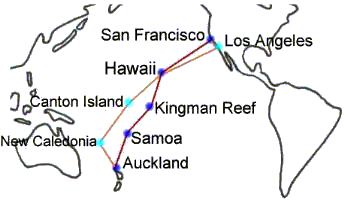
The route
The route from Auckland to San Francisco was via Noumea in New Caledonia, Canton Island, Honolulu and Los Angeles. Different cachets were applied at each departure point.
The Auckland to Noumea leg of 1124 miles was on 20 July. The Boeing 314 flying boat American Clipper then left Noumea on 21 July and arrived at Canton Island on 20 July having crossed the International Date Line. Canton Island to Honolulu (1913 miles) was on 22 July while Honolulu to Los Angeles (2561 miles) was on 23 - 24 July. The final leg of 365 miles from Los Angeles to San Francisco was on 24 July.
Care must be exercised in interpreting dates as some publications (e.g. [7])
give all dates from the perspective of the USA
and therefore show the leg from Auckland to Noumea being on 19 July (US time)
rather than 20 July (NZ time).
Most other publications (and this website) use local times.
Proud shows a copy of the timetable for the service [8].
New Zealand to USA
to San Francisco
The flight left Auckland at 8am on Saturday 20 July [8] and all mail was postmarked on the previous day. A special cachet was applied. The New Zealand Post Office advertised the postage rate to the USA at 4s 0d while the US stated that the cost was 3s 6d [1]. The total mail flown from Auckland to San Francisco was 13,794.
As this cover was prepared by an American collector, it is only franked with 3s 6d.
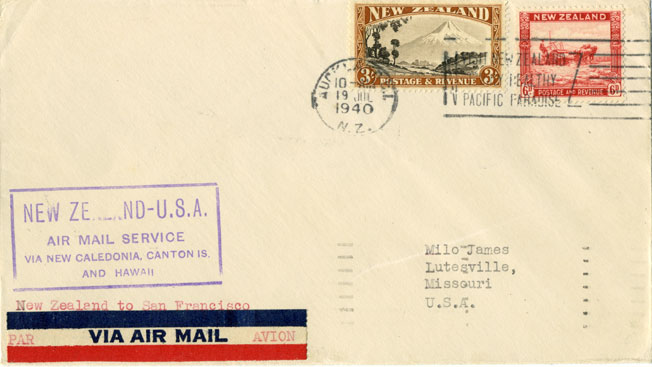

According to the timetable given in Proud [8], the flight was due to arrive in San Francisco at 2pm on July 24. The San Francisco backstamp was applied with a time of 4pm.
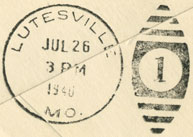
The above cover would then have been carried by internal US airmail
from San Francisco to Missouri.
It arrived in Lutesville, Missouri on 26 July where a further
backstamp was applied.
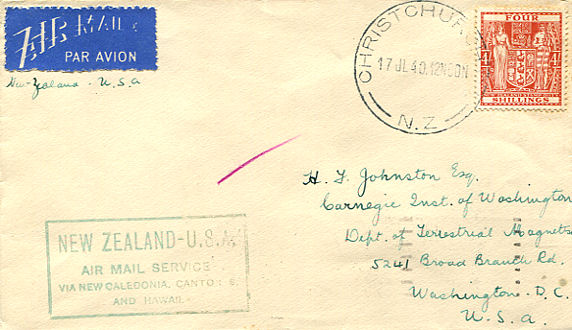
Cachet in green
This cover is postmarked in Christchurch and is franked with 4s 0d.
New Zealand first flight cachets were applied in Christchurch, Dunedin and Wellington as well as in Auckland. That mail was then flown in sealed bags by a Lockheed Electra of Union Airways ready to be loaded on the clipper in order to lessen the last minute rush.
Christchurch was unusual for, as in this example, the colour of the cachet
was green.
Most collectors sent their covers for the flight in envelopes to
the Auckland Post Office to be handled there
and so covers with the green Christchurch cachet are not common.
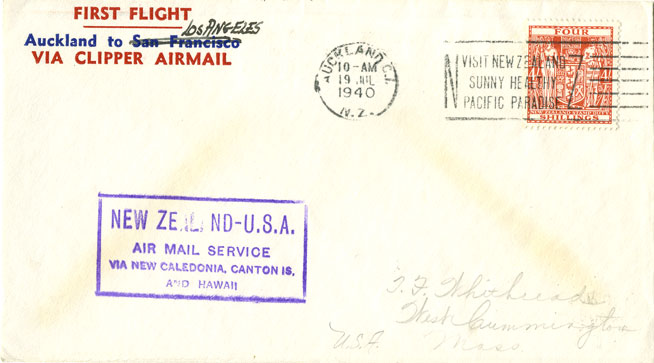
to Los Angeles
The next cover followed the NZ Post Office instructions and carries a 4s 0d stamp. It is addressed to Los Angeles and so was off-loaded in San Pedro which was the where the Los Angeles terminal was sited.

Although the flight arrived at 10am on July 24 [8], it was not
backstamped in Los Angeles until 5pm which.
is an hour later than the San Francisco backstamp.
The total mail flown from Auckland to Los Angeles was 2,459.
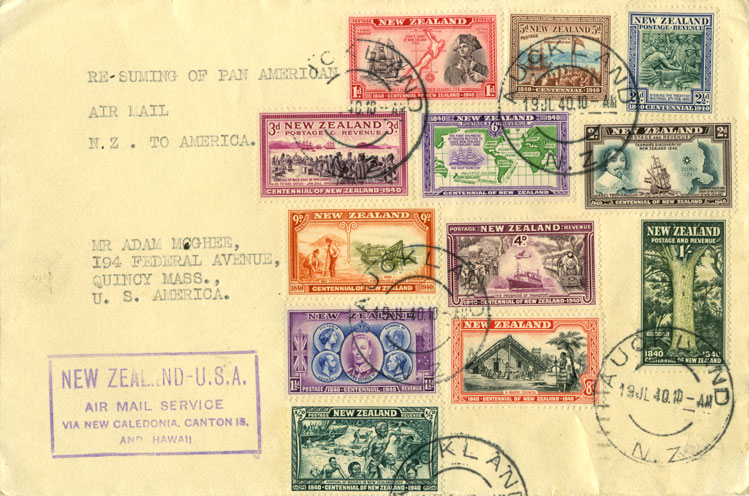
Centennial Set
The next cover is franked with the New Zealand Centenary set and so is overfranked by 6½d.
Neither this nor any of the other covers were opened by the censor in Auckland. Indeed, I have not seen a cover whose only postmark was on 19 July in Auckland and which was opened by the NZ censor.
Perhaps the volume of mail that had to be handled was so high
that the normal rules were not applied.
Mail to the UK
The cost of airmail postage from New Zealand to the UK via San Francisco was 6s 3d per ½oz. Only 863 items were carried on the first flight to UK and Europe.
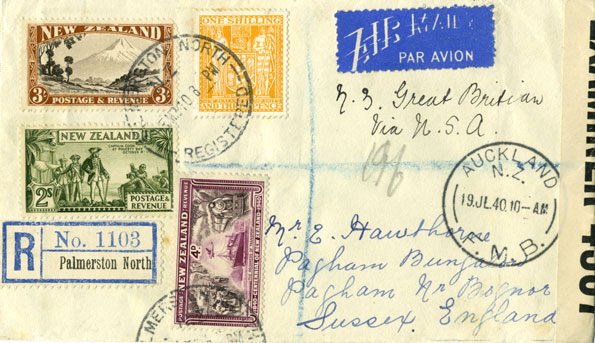
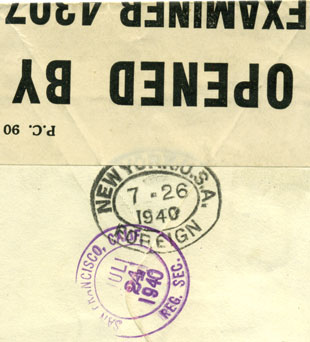
Mail for the UK was not normally backstamped in San Francisco, but as the shown cover is registered, it has a San Francisco backstamp on 24 July and a New York backstamp on 26 July. It does not, however, have the usual first flight cachet. It has postage of 6s 7d to include the 4d registration fee.
From San Francisco, the mails were flown to New York and from there to Lisbon on the trans-Atlantic Pan Am route. A BOAC service between London (Heston) and Lisbon via Bordeaux had been started on 4 June flown by a DH 91 Albatross landplane, but from 19 June that had been replaced by a BOAC flying boat service between Lisbon and Poole and that would have been used for this flight [11].
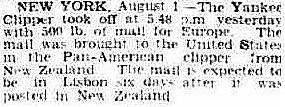
According to a report in The Advertiser of Adelaide on 2 August, the mail was flown by the Yankee Clipper from New York on 31 July which arrived in Lisbon on 1 August [14]. Mail from that flight subsequently arrived in London on 4 August [12]. The quote of six days to reach Lisbon from New Zealand is obvious nonsense. (There is a similar report in The Times of 2 August.)
Walker reports that the mail arrived in the UK on 3 August and I have seen one cover backstamped in Huddersfield on 3 August and another that was redirected in London on 2 August. It therefore seems clear that the mail was actually flown from New York to Lisbon on 29-30 July by the Dixie Clipper [7]. That mail arrived in London on 2 August [15].
In response to my article on Alternatives to the Horseshoe Route [4], Alan Berry suggests that the San Francisco - New York leg was by surface and that the dates on this cover support that conjecture [5]. However, given the size of the mail, that the normal San Francisco backstamp was not until 4pm on 24 July, that the Canadian and Missouri backstamps shown on this page are also backstamped 26 July and the time by rail from the West to the East coast of the USA, it is clear that the mail was flown from San Francisco to New York [9].
This cover was not opened by the censor in New Zealand, but was opened by the censor on arrival in the UK which is unusual as mail from New Zealand was not usually sent to the UK censor.
As the Cairo - London section of the through airmail route from New Zealand to the UK had been suspended on 11 June, the new US route was the only through airmail route to the UK as the alternative Horseshoe Route involved a sea journey from Durban to the UK.
Double rate
The following cover was overweight and so has franking of 12s 6d. It is postmarked in Wellington on 18 July and was opened there by the censor. The cachet would have been applied in Wellington.
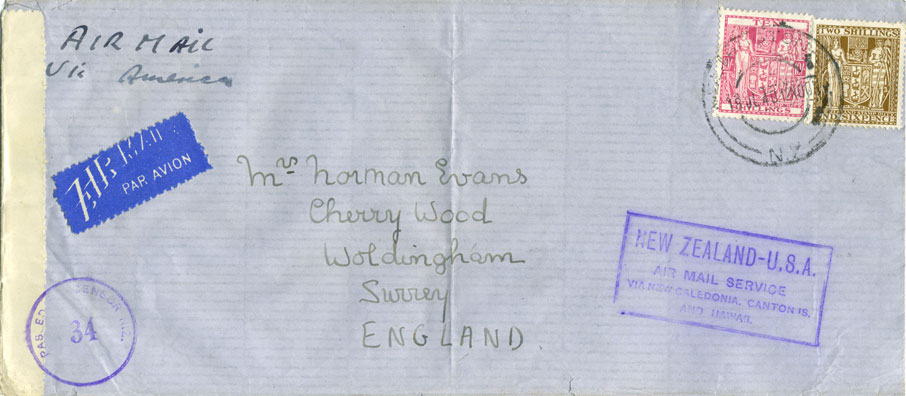
Mail from Australia
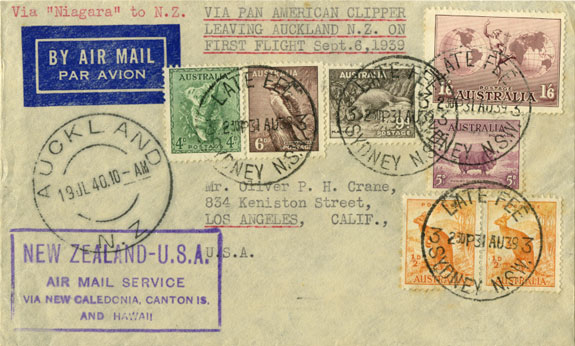
Australia - NZ - USA
The Pan Am survey flight from San Francisco had arrived in Auckland on 30 August, 1939 and it was expected that mail would be flown on the return flight on 6 September. The Australian Post Office advertised this service with the connecting mail closing in Sydney at 2pm on 31 August [13].
However, due to the imminent start of WWII, the clipper left on 2 September and carried no mail.
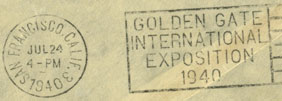
This cover has routing instructions that it was to be flown from Auckland on 6 September. It is postmarked in Sydney at 2.30pm on 31 August, 1939 and because this was after the closing time of 2pm, it has a 1d late fee within the franking of 3s 7d. It was carried from Sydney to Auckland on the RMS Niagara and, after arriving in Auckland in September 1939, it was held there until July 1940 and then flown on the first official airmail flight. Several similar covers sent from Australia in August 1939 are shown in [10].
Although it is addressed to Los Angeles, it was backstamped on
arrival in San Francisco.
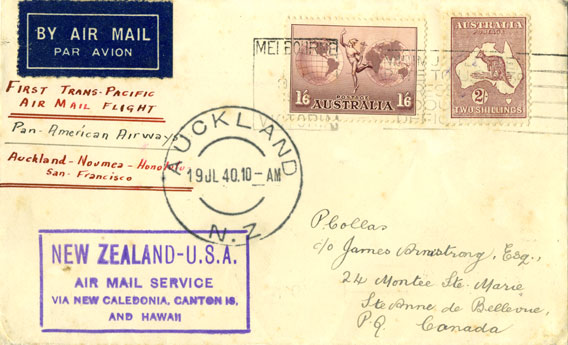
Australia - NZ - USA - Canada
Mail for the flight which left Australia in July 1940 and was initially flown trans-Tasman to New Zealand by TEAL on 18 July. This cover was first postmarked in Melbourne and then again on 19 July in Auckland where the first flight cachet was applied.


It was then flown to San Francisco where it was backstamped on 24 July. It was then flown to Canada and arrived in St Anne de Bellevue in Quebec where it was backstamped on 26 July.
The rate from Australia to Canada was 3s 11d [3], but there was
the same confusion over rates for the first flight [1]
and both these covers have a franking of 3s 6d which was the rate
advertised by the US Post Office.
Intermediate Legs
New Zealand to New Caledonia
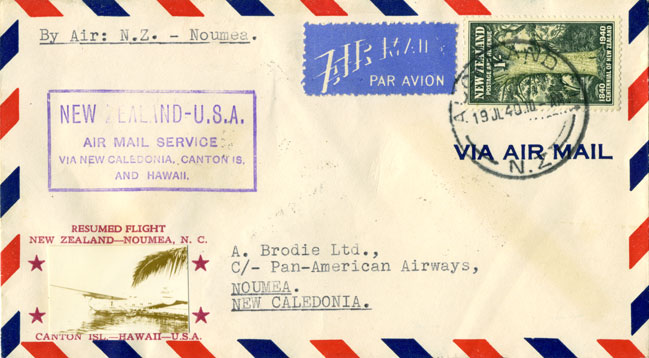
This was the first flight from New Zealand to New Caledonia. The flight left Auckland on 20 July and arrived in Noumea, New Caledonia the same day.
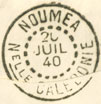
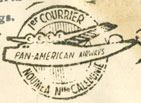
Two backstamps were applied on arrival in Noumea, one giving the date and the other the Pan American Airways cachet that had been applied on the flight from New Caledonia to New Zealand.
This cover was postmarked in Auckland on 19 July and
has the correct franking of 1s 0d.
The size of the mail from New Zealand to Noumea was 6,590.
The cover has a cut out photograph of a clipper in the bottom left.
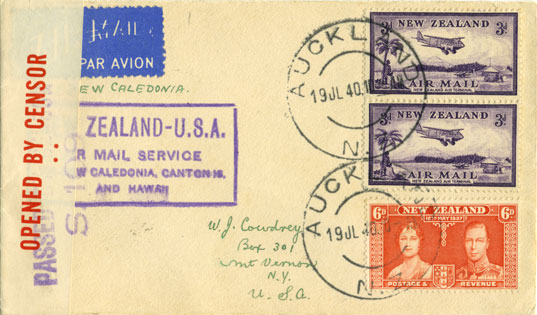
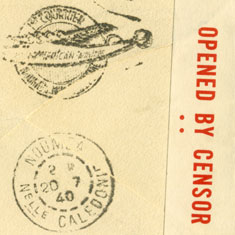
Although this next cover is addressed to the USA, it was only flown on the New Zealand to New Caledonia leg and the appropriate New Caledonia backstamps were applied on arrival.
The question of its subsequent route to the USA is answered by the presence of Australian censor tape. That shows that it was sent to Australia by sea where it was opened by the censor in Sydney as indicated by the two red dots. It would then be sent by steamer from Australia to USA.
The above two covers have slightly different cachets.
In the first, there is a full stop after HAWAII while
in the second there is no full stop and the last I of
HAWAII is out of alignment.

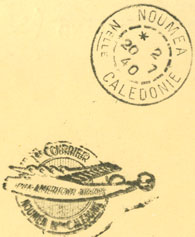
Cachet in green
The next example is an uprated printed postcard sent on the first flight. The rate for postcards was half the letter rate and so it has the correct franking of 6d.
As it is postmarked on 17 July in Christchurch, the colour of the cachet is green, as in the second example above. The postcard was flown from Christcurch to Auckland. The internal New Zealand air mail service normally cost an extra 1d, but, unlike the situation with the 1938 trans-Pacific flight, this time there was no extra charge.
It should be noted that the New Caledonia arrival backstamps in the three example covers
are all different.
New Zealand to Canton Island
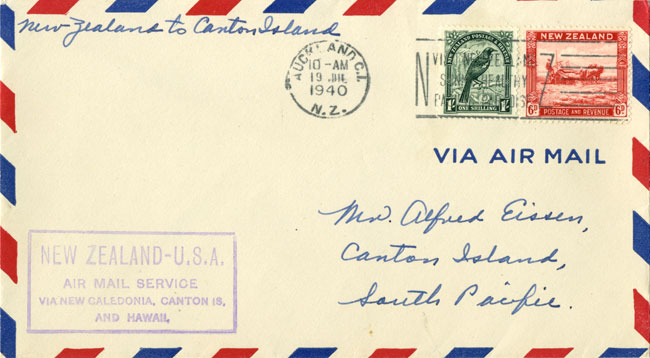
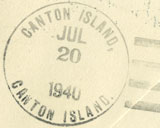
Two covers to Canton Island are shown, one from New Zealand and the other from New Caledonia.
The first cover was flown from New Zealand to New Caledonia on 20 July. It then left New Caledonia on 21 July and arrived at Canton Island on 20 July having crossed the International Date Line.
It has postage to the value of 1s 6d which was the rate
published by the US postal authorities while the New Zealand
authorities published a rate of 1s 9d.
The size of the mail from New Zealand to Canton Island was 4,739.
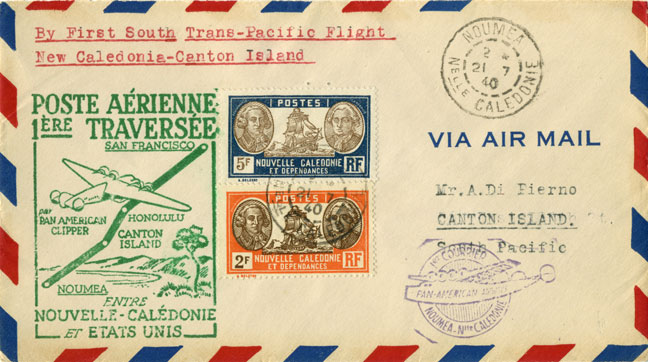
New Caledonia to Canton Island
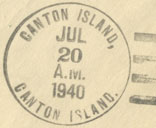
This cover is postmarked 21 July and, because of crossing the International Date Line, it arrived in Canton Island the day before it was posted and has an arrival backstamp of 20 July.
The size of the mail from Noumea to Canton Island was 5,650.
Because of the volume of mail, more than one Canton Island
backstamp was used.
The backstamp on the cover from
New Caledonia contains an extra A.M. compared with the backstamp
on the cover from New Zealand.
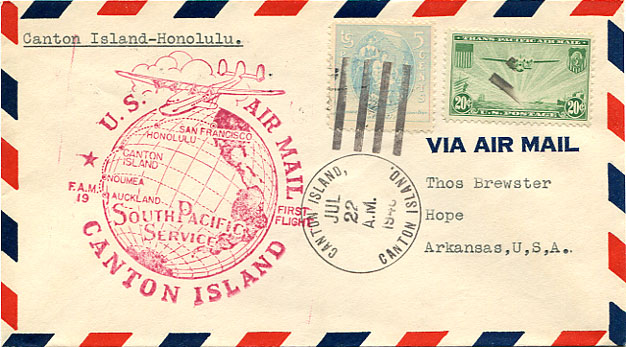
Canton Island to Hawaii

Although the clipper arrived at Canton Island on 20 July, it did not leave until 22 July.
This cover is one of the 5,326 items flown on the Canton Island to Hawaii leg. It is postmarked in Canton Island on 22 July and backstamped later that day at 5.30pm. It is franked with 25c.
The cachet that was applied was the official cachet that had been
delivered to Canton Island on 14 July on the flight from San Francisco.
The mail that had been flown south on 15 July
has an unofficial Pan American cachet.
New Zealand to Hawaii
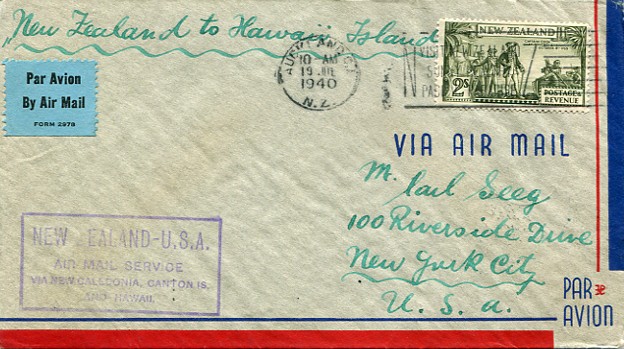

As with the rate from New Zealand to the USA, the New Zealand and US Postal Services published different rates for the New Zealand - Hawaii leg. According to the US authorities, it was 2s 0d while New Zealand published the rate as being 2s 6d.
As this cover is franked with 2s 0d, it would have originated in the USA. It is backstamped in Hawaii at 5.30 pm on 22 July and would then complete its journey from there by sea.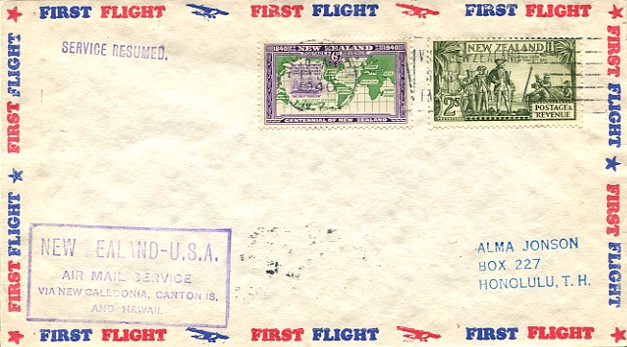

This second cover to Hawaii is franked with the New Zealand published rate of 2s 6d and so would be send by a New Zealand correspndent. As with the other cover, it is backstamped in Honolulu, Hawaii at 5.30 pm on 22 July
The quantity of mail sent from Auckland to Hawaii was 5,736.
Connection with FAM 14 at Hawaii
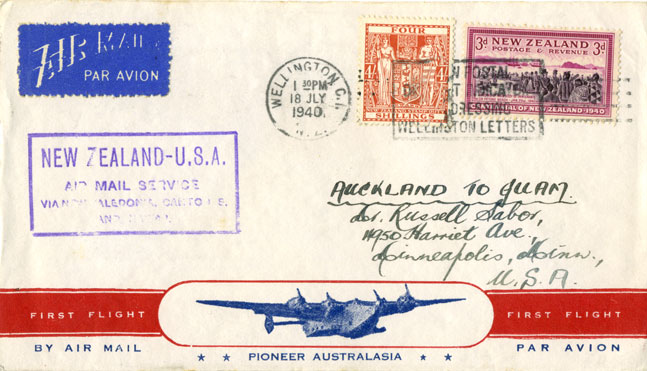
To Guam
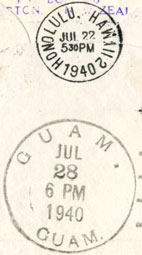
This cover to addressed to Guam and is correctly franked with 4/3.
It was first flown to Hawaii where it was backstamped on 22 July. It then connected with the Pan Am route FAM 14 from Hawaii to Hong Kong. This was flown by Boeing B-134 via Midway, Wake Island and Guam and the Philippines.
The cover has a Guam backstamp of 28 July.

To Hong Kong

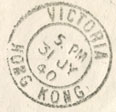
This cover also connected with the Pan Am route FAM 14 at Hawaii, but this time was flown al the way to Hong Kong. It has a Hong Kong backstamp on 31 July and is correctly franked with 5s 3d. That was also the postage rate to Macao, China and Japan while the rate to the Philippines was 5s 0d [1].
These last two covers are obviously philatelic in nature and have the
same US address.
All scans were made by the author.
Information on this page is taken from:
Airmails of New Zealand, volume 2 (1986) compiled by
Douglas A Walker, and
The New Zealand Airmail Catalogue, (2nd Edition, 1994)
by James Stapleton.
Both are published by the
Air Mail Society of New Zealand
[1] M Shand, New Zealand - USA Air Mail Service - What was the Postage Rate?,
The Kiwi, vol 49, p 135, November 2000.
[2] Q 271, K A Griffiths, Air Mail News, vol 45,
pp 97-98, August 2002.
[3] Legg, W.H., Wartime Interruptions to Airmail Routes,
Air Mail News, vol 47, pp 46-53, May 2004.
[4] Clark, R., Alternatives to the Horseshoe Route in June and July 1940,
The Kiwi, vol 58, pp 42-47, March 2009.
[5] Berry, A., Notes on the Report on the Perforations Workshop and the
Horseshoe Route in the last issue of the Kiwi,
The Kiwi, vol 58, p 61, May 2009.
[6] Krupnick, J.E., Pan American Pacific Pioneers, 1997.
[7] Bridging the Continents in Wartime: Important Airmail Routes 1939-45,
H. E. Aitink and E. Hovenkamp, SLTW, Enschede, 2005.
[8] Proud, E.B., The Postal History of British Air Mails, Proud-Bailey, 1991.
[9] Clark, R., New Zealand Air Mail to the United Kingdom and Canada via
the United States in 1940-41: Was it flown within the United States?,
The Kiwi, vol 58, pp 128-133, November 2009.
[10] Legg, W.H., A Delayed Flight,
Air Mail News, vol 41, pp 69-74, June 1998.
[11] Overseas Mail Branch Weekly Report No 41, 22 June, 1940, POST 56/76
Royal Mail Archive.
[12] Overseas Mail Branch Weekly Report No 48, 10 August, 1940, POST 56/76
Royal Mail Archive.
[13] Lee, R., Australian Mail by Air via NZ to GB 1939, New Zealand Air Mail
News, no 659, pp 4-6, June 2006.
[14] Australian Newspapers 1803-1954,
Trove, National Library of Australia
[15] Overseas Mail Branch Weekly Report No 47, 3 August, 1940, POST 56/76
Royal Mail Archive.